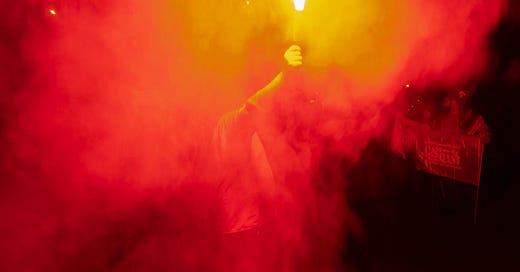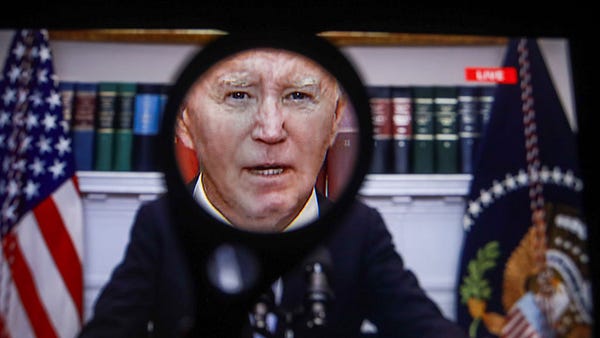
The Free Press

JERUSALEM — After a night of tension and aerial booms here in Jerusalem—including family time spent in the safe room as the air-raid siren blared in the street and the Iron Dome worked overhead—the direct consequences of the unprecedented Iranian attack on Israel aren’t clear yet. But like a flash going off in a dark room, the attack has finally given the world something valuable: a glimpse of the real war in the Middle East.
For the past six months, since the Hamas massacres of October 7, the ideological forces arrayed against Israel have done their best to make this seem like a war in which there are two sides, and that these sides are Israeli soldiers and Palestinian civilians. This information campaign is as critical to Israel’s enemies as the physical war, because it erodes the Western support that Israel needs to win and survive. Its successful execution has turned a jihadi war against the Jewish minority enclave in the Middle East into a story about Jewish oppression and even “genocide” of Palestinians, a story that has become the focus of the increasingly deranged discourse in the liberal West.
Israel’s ideological antagonists these days, unfortunately, aren’t only Hamas and Iran, but now include swaths of the Western press and academia as well as the NGO world that provides much of the fodder for Western storytelling. (Look no further than Olivia Reingold’s report from a conference of anti-war activists in Chicago as news of the attack broke.) This is the main reason so many observers struggle to understand what’s going on. As in previous rounds of fighting in Gaza, the Hamas tactic of hiding fighters and weapons behind civilians, and of feeding false casualty numbers and selective images to a credulous press, generated an overpowering impression of needless civilian tragedy—and thus outrage designed to tie Israel’s hands as well as generate animosity toward Jews around the world.
This largely fictional narrative is a continuation of many years of press coverage insisting that the story here is an “Israeli-Palestinian conflict,” a framing that sets up the region’s six million Jews as a powerful majority and the region’s hundreds of millions of Arabs and Muslims, the vast majority of whom are not Palestinian, as a beleaguered minority.
The truth is that there isn’t an “Israeli-Palestinian” conflict that exists in isolation. There’s an Arab-Muslim war with Jews that’s about a century old, in which most of the combatants on the Arab side have not been Palestinian and some of the Jewish victims haven’t been Israeli (like the Argentinians killed by Iranian terrorists at a Jewish community center in 1994, for example, or the masses of Jews forced from their homes in the Islamic world after Israel’s founding). These days, the relevant conflict is between the alliance led by the Shia clerics of Iran’s Islamic Republic against states in the American orbit, most of them Sunni, like Jordan and Saudi Arabia, and one of them Jewish.
Last night should make clear, for those still in doubt, that Gaza is just one part of the broader story of Iran’s growing power and its tightening encirclement of Israel. When understood in this context, the behavior of Israel and its opponents becomes easier to understand.

Hamas and Islamic Jihad in Gaza are one link in the Iranian encirclement. The Houthis in Yemen, who have been harassing commercial ships and firing at Israel’s southern port of Eilat, are another link. The Iranian-backed militias in Iraq make up a third. The Iranian forces and proxies in Syria, including the Revolutionary Guard commanders killed in the recent Israeli airstrike in Damascus, are a fourth. (The strike on April 1, which came after months of attacks against Israel by proxies directed and armed by the Revolutionary Guards, is typically being cast by Israel’s opponents as an unprovoked attack on a diplomatic facility, as if the commanders were cultural attachés in town for a goodwill concert.) Lebanon’s Hezbollah, whose bombardments have depopulated a swath of northern Israel since October 7, is the fifth. If you look at a map, you’ll see that Iran has methodically installed proxies that can strike Israel from almost any direction except the west, where we border the Mediterranean.
The importance of last night’s barrage was that for the first time, the full Iranian alliance gave us a practical demonstration of its scope, orchestration, and intentions. The radical departure here was that the Islamic Republic itself dared to attack directly for the first time. If you’d been watching from space, you probably could have seen the lines of this new Middle East etched in orange and red across the map of the region. You might have also seen the second part of the story, which is the successful defense mounted not just by Israel but by the U.S. and Britain, and also by Jordan and, apparently, by Saudi Arabia—a welcome development hard to imagine a few years ago, and still puzzling to a Western observer fed stories about an “Israeli-Palestinian conflict.”
Whether this attack was a masterstroke or an error by Iran will eventually become clear. But it’s already obvious that they’ve done observers a favor by emerging from the shadows to end any doubt about what this war is and who’s fighting it.
Matti Friedman is a Jerusalem-based columnist for The Free Press. He’s the author of four nonfiction books, including most recently, Who by Fire: Leonard Cohen in the Sinai. Read his Free Press piece, “Why I Got a Gun.”
Become a Free Press subscriber today:














About 2 months ago, I listened to an Israeli injured on 10-7. In a matter-of-fact manor, he said he understood both Palestinians and Israelis were proxies in much larger wars.
China, Russia, N. Korea and Iran are all on one side. Israel and a healthy chunk of the west are on the other. I say a healthy chunk of the west because our collective knees have gotten very weak.
I believe Iran's recent, direct attack on Israel was a test to see Biden's response & Israel's defense capabilities. A similar Iranian attack with a Hezbollah involvement could easily have overwhelmed Israeli & "coalition" defenses. Israel must resort to a preemptive strike on Iran & Hezbollah. There are those who will say that this would lead to a regional war as if there isn't a regional war. The Iranian hegemony will only continue & most likely escalate. Biden's acceptance of Iran's tit for tat is idiotic but then his whole approach to Iran is Obuma idiotic.